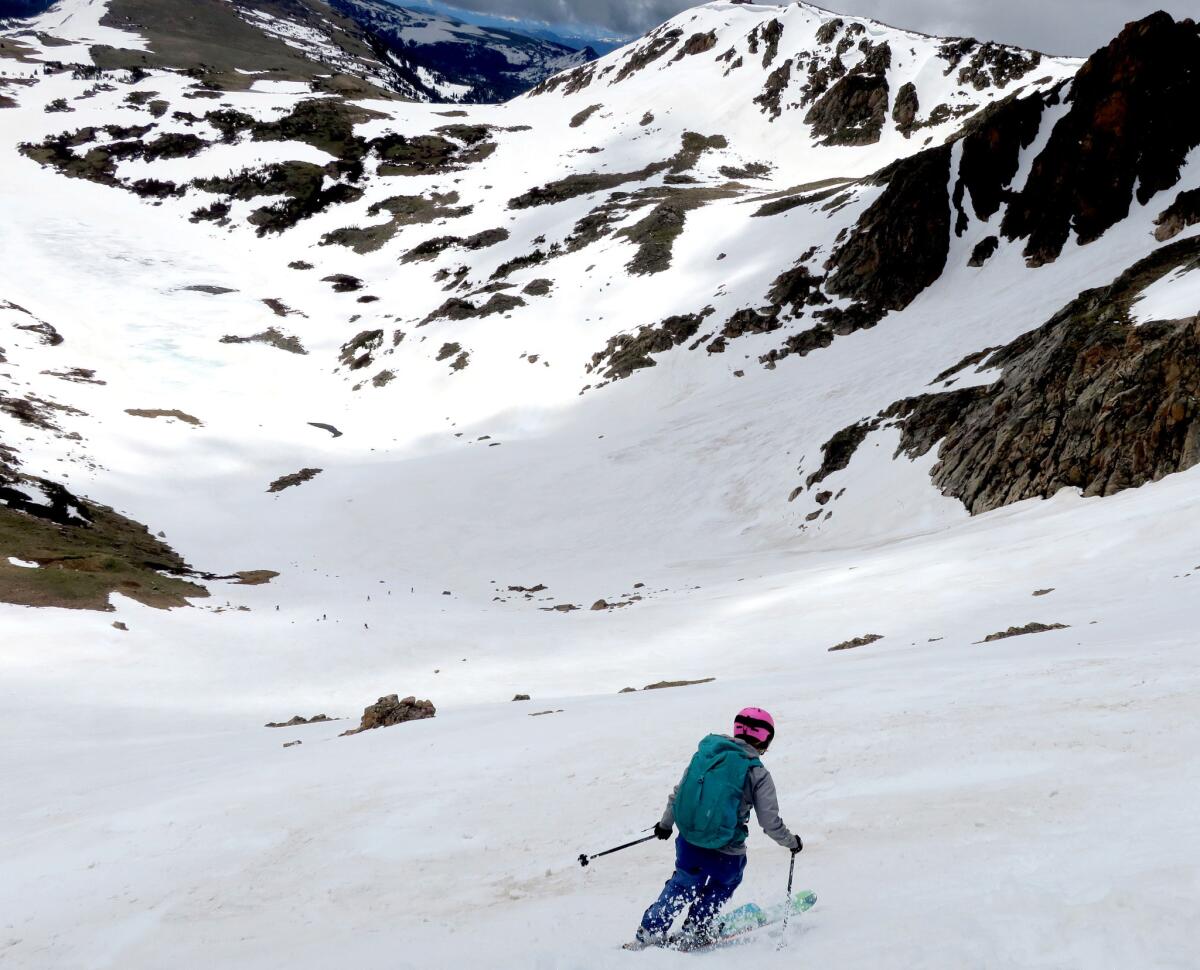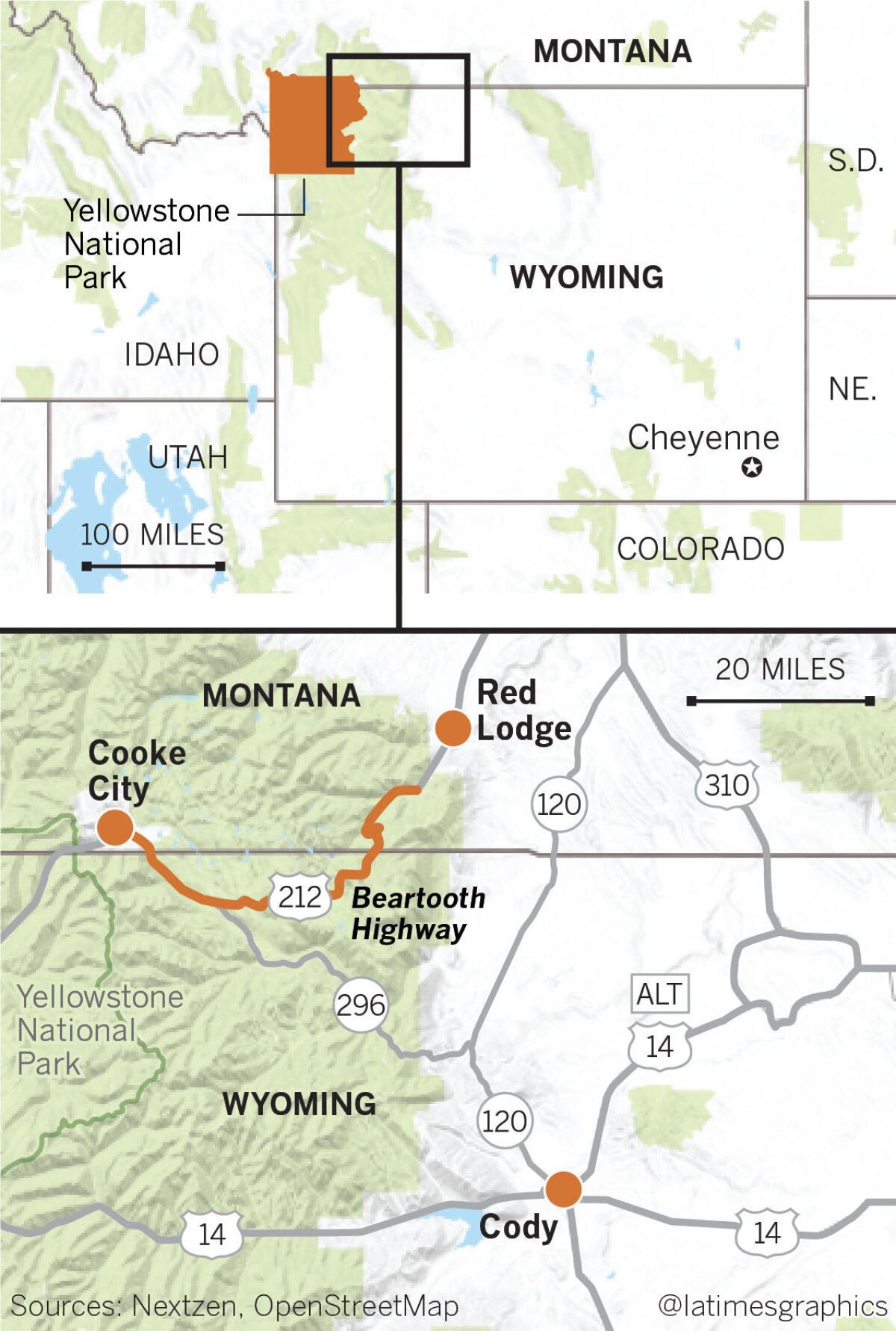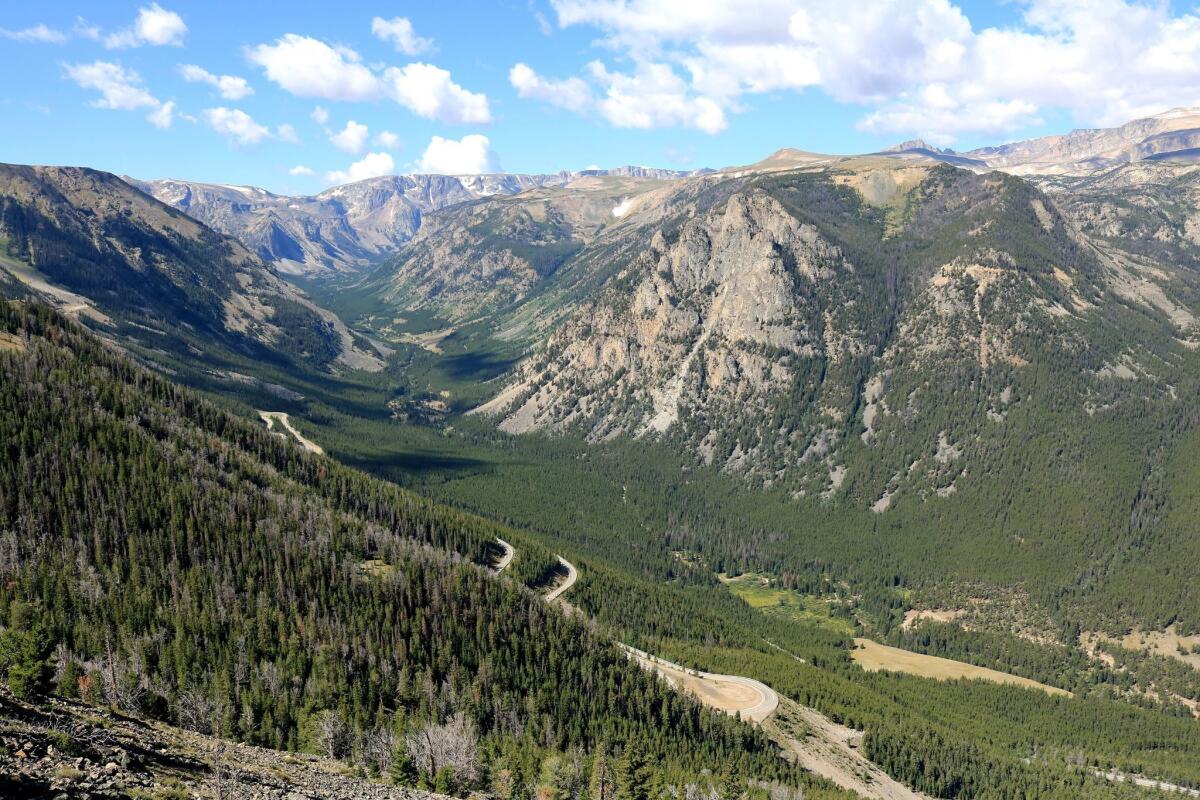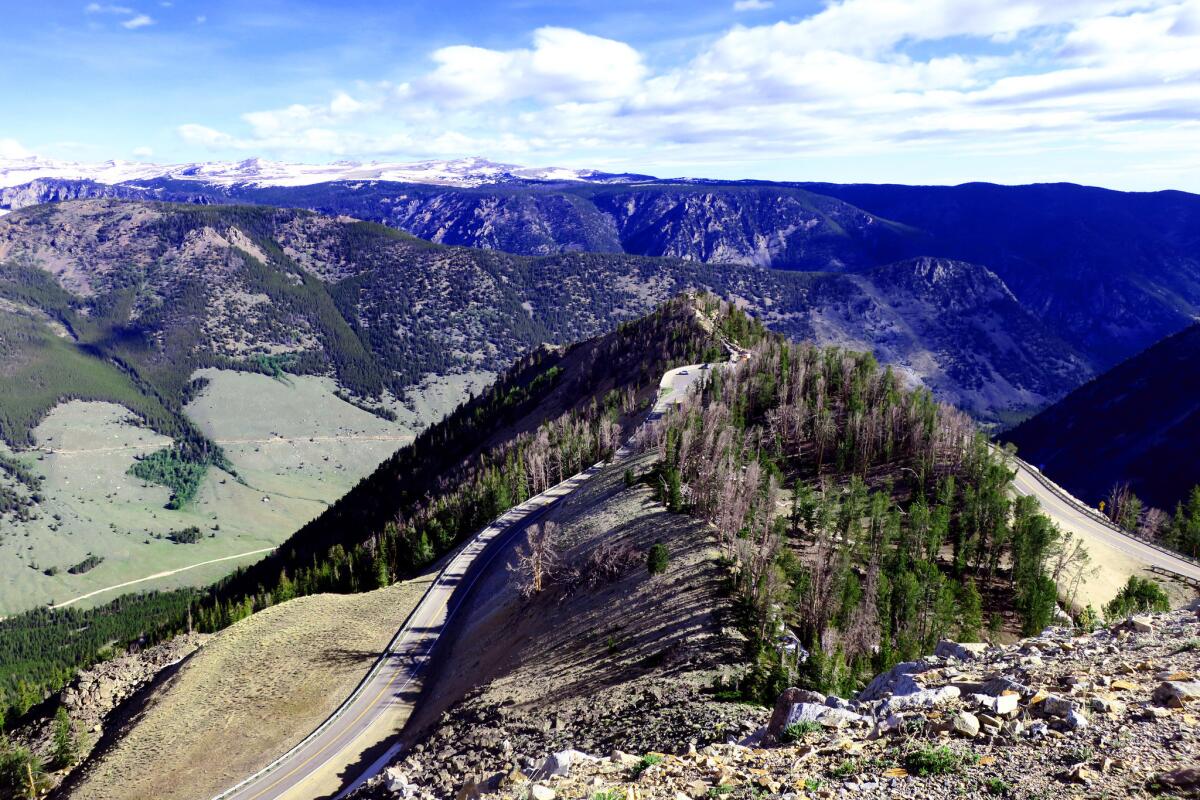Beartooth Highway is fearsome fun, whether you’re driving it or skiing it
- Share via
It’s safe to assume, I think, that any road named after a grizzly bear’s fang will inevitably lead to adventure.
Beartooth Highway, a 68-mile ribbon of pavement snaking across an otherworldly 11,000-foot plateau along the southwest Montana-northwest Wyoming border, lives up to the ferocity of its name.
U.S. 212 climbs more than 4,500 vertical feet over a dizzying series of switchbacks as it travels south from the tourist town of Red Lodge. It dips into Wyoming and tops out at 10,947 feet on Beartooth Pass, ending in the tiny outpost of Cooke City, Mont., just outside the northeast entrance to Yellowstone National Park.
Snow keeps it closed much of the year, but from Memorial Day to mid-October the highway comes to life. Many road-trippers visit just to experience it. Skiers, cyclists, hikers and anglers come to explore the wild Beartooth Plateau.
In the 1990s, CBS newsman Charles Kuralt of “On the Road” fame called Beartooth Highway “the most beautiful drive in America,” and nobody has argued otherwise since.
Skiing the highway

When the Beartooth Highway opens, ski season opens with it. The high-elevation snows last well into summer, drawing a hardy crowd of backcountry schussers who drop into the chutes, a steep slope at the top of a glacial valley, and headwalls, just off the roadway.

On a cool morning in mid-June last year, skiers gathered at a parking pullout on top of the plateau near the Wyoming state line. Keith Miatke had driven from central Wisconsin to be among them.
As another car arrived, he tapped on the window and asked, “Do you want to ski the Rock Creek Headwall?”
Like others here, Miatke was looking for a partner to ski one of the highway’s signature drops. Rock Creek Headwall falls 1,800 vertical feet from the plateau to a highway switchback below.
Soon enough, Miatke found partners. Steve Blote, a commercial pilot from Rapid City, S.D., and Grace, his 14-year-old daughter, joined Miatke for a half-mile hike across the plateau to the rock-strewn headwall entrance.
First Miatke dropped in, then Blote and his daughter, carving turns in the skiable corn snow. At the bottom, the exhilarated group reassembled, shared high fives and then loaded into Blote’s truck for a drive back to the top.
Dozens of other skiers follow this same routine on a typical day, arranging car shuttles or hitchhiking.
“This is the way skiing used to be before there were resorts,” Miatke said with a satisfied grin.
Another favorite run off the highway is on the Wyoming side, near Beartooth Pass. It’s called the Gardner Headwall, falling about 700 vertical feet into a wide basin.
Besides these highway-accessed runs, a small ski resort operates until early July most years. Beartooth Basin, a 500-acre, 1,000-vertical-foot ski area with two platter lifts, offers access to the steep Twin Lakes Headwall in Wyoming. It is scheduled to open May 27 this year.
The ski area sells tickets out of a travel trailer on a highway pullout. Before you can ski Beartooth Basin, you must sign a release.
Indeed, skiing along the Beartooth Highway doesn’t come without risks. In June, a 19-year-old skier from Bozeman, Mont., died after falling 1,100 feet down a chute near Beartooth Pass.
Beartooth beginnings

It was 1919 and Beartooth Plateau, named for a distinctive peak the Crow Indians called Na Pet Say (“the bear’s tooth”), was a wilderness visited only by miners and fur trappers.
In Red Lodge, a coal mine that employed most of the town was in decline, and civic boosters were worried.
“The economy was really in a slump, so Red Lodge decided to shift its emphasis to tourism,” said Samantha Long of the Carbon County (Mont.) Historical Society.
Yellowstone National Park was bringing in thousands of visitors. Why not get a piece of that pie?
Business interests from Red Lodge built a part of the Beartooth Highway and surveyed the rest of the route to Cooke City, then began lobbying Congress to pay for it.
In 1931, the new “Yellowstone approach road” was approved. Five years later it opened.
Over the years, the highway gained fame for its beauty. In 2002, the U.S. Department of Transportation designated it an All-American Road, the most prestigious honor in the agency’s scenic byways program.
From the beginning, the Beartooth Highway proved difficult to maintain. Some years, snowdrifts are 40 feet deep along the windy plateau and must be painstakingly cleared, said Ken Hembree, maintenance superintendent for the Montana Department of Transportation in Billings.
Crews start plowing snow in mid-April for the late-May opening.
Avalanches also plague parts of the highway, requiring crews to remove and reinstall guardrails every year, Hembree said. In 2005, a major landslide took out part of the road, closing it for most of the summer.
Montana plows its side of the roadway diligently, but Wyoming does not, leaving snow removal to crews from Yellowstone under a longstanding agreement.
Exploring by motorcycle, bicycle, foot

Beartooth Highway is a favorite of motorcyclists, who love the scenery and the thrill of riding twisties, said Nick Haris, Western states representative of the American Motorcyclist Assn.
“It’s probably in everyone’s top five rides in the country,” he said.
For bicyclists, the road is a gorgeous climbing challenge, rising nearly a vertical mile from Red Lodge.
As the snow melts, hiking and fishing are accessed off the highway amid the plateau’s many lakes, streams and waterfalls.
The most popular hike near Red Lodge is the Lake Fork Trail in the Custer Gallatin National Forest, which gets around 15,000 visits a year.
On the Wyoming side, many short hikes are just off the highway in the Shoshone National Forest at Beartooth and Island Lakes, and at Clay Butte, a former fire lookout.
Longer backpacking adventures lead into the rugged nearly million acres of Absaroka-Beartooth Wilderness, topped by Granite Peak, the highest point in Montana at 12,799 feet.
Fishing for cutthroat, rainbow and brook trout is seemingly everywhere. Snowmelt fills rushing streams, which in turn fill the hundreds of lakes on the Beartooth Plateau.
If you go
The gateway communities of Red Lodge, Mont., and Cody, Wyo., are good places to stay during a visit to Beartooth Highway.
Red Lodge has many lodging options, bars, restaurants and shops. The historic Pollard Hotel (2 N. Broadway Ave., Red Lodge, Mont.; (406) 446-0001; doubles from $248 a night) sits downtown in a building that dates to 1893. Camping is available along the highway in the Custer Gallatin National Forest.
Cody is all about namesake Buffalo Bill, who helped found the town in 1895. The Buffalo Bill Center of the West, a Smithsonian Affiliate, is celebrating its 100th anniversary this year. It is filled with memorabilia, paintings, guns and an entire branch devoted to Plains Indians.
The historic Irma Hotel (1192 Sheridan Ave., Cody, Wyo.; [307] 587-4221; doubles from about $150) named for Cody's daughter, is at the center of town. If you’re hankering for a real rodeo, there’s one every night during the summer at the Cody Stampede just outside of town.
Sign up for The Wild
We’ll help you find the best places to hike, bike and run, as well as the perfect silent spots for meditation and yoga.
You may occasionally receive promotional content from the Los Angeles Times.



